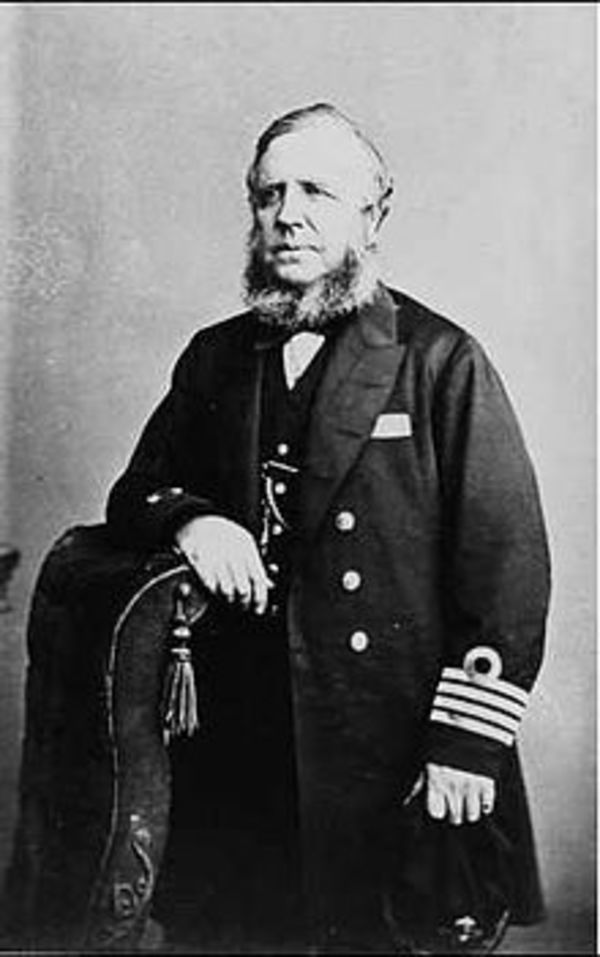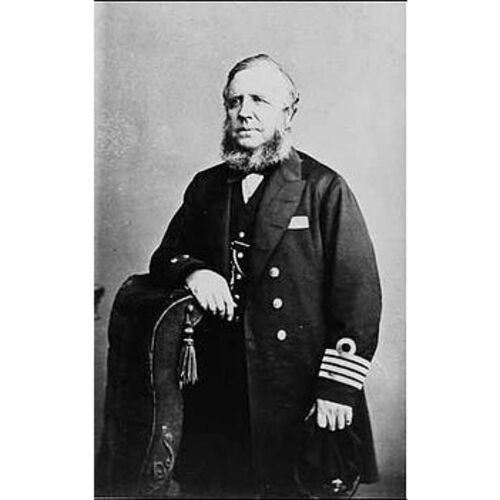
Source: Courtesy of Wikimedia Commons
PULLEN, WILLIAM JOHN SAMUEL, naval officer and Arctic explorer; b. 4 Dec. 1813 at Devonport, England, second child and eldest son of Lieutenant William Pullen and Amelia Mary Haswell; m. 25 Aug. 1845 Abigail Louisa Berton at Saint John, N.B., and they had four sons and one daughter; d. 11 Jan. 1887 at Torquay, England.
William John Samuel Pullen was educated at the Greenwich Hospital school and following family tradition entered the Royal Navy on 15 June 1828 as a 1st class volunteer. He served in the Mediterranean in the mid 1830s and in 1835 met Colonel William Light, surveyor general of South Australia, who persuaded Pullen to accompany him in 1836 to the new colony as an assistant surveyor. Pullen remained there until July 1841 surveying the mouth of the Murray River and the adjoining coast. He then returned to England and in May 1842 rejoined the navy as a mate. On 14 July 1842 he was appointed to hms Columbia under the command of Captain William Fitz William Owen* and later of Lieutenant Peter Frederick Shortland and was employed in surveying the Bay of Fundy and the Saint John River. Pullen was promoted lieutenant on 9 Nov. 1846 and remained on the Columbia until she was paid off in 1848.
As was the custom, Pullen, the junior lieutenant, was sent to the Admiralty to return the charts and chronometers. In London he accepted an appointment, 12 May 1848, as 1st lieutenant under Captain Thomas Edward Laws Moore in hms Plover. The Plover was to sail for the Bering Strait as a base ship for an expedition in search of Sir John Franklin*. The expedition, which included Captain Henry Kellett* and hms Herald, reached Chamisso Island in Kotzebue Sound, Alaska, on 15 July 1849 and Pullen was sent by Moore with two boats to search the coast near Cape Lisburne for a winter berth. He was unsuccessful and the ships proceeded to Wainwright Inlet.
On 27 July Moore ordered Pullen to set off with two officers and 22 men in four boats to search the north coast of the continent as far east as the Mackenzie River for signs of Franklin. At Point Barrow (Alaska), on 2 August, Pullen found the ice conditions so severe and the sea so shallow that two days later he sent the two largest boats back to Wainwright Inlet. With the Mackenzie River still some 500 miles to the east, Pullen and the remainder of the party continued along the shallow waters of the relatively unknown coast. Despite bad weather, and encounters with aggressive Inuit, Pullen reached the mouth of the Mackenzie on 2 September, and four days later he arrived at Fort McPherson (N.W.T.). The party was then dispersed to winter at the various Hudson’s Bay Company posts in the area, such as Fort Franklin and Fort Simpson.
On 20 June 1850 Pullen and his men left Fort Simpson with Dr John Rae*, an HBC officer in the Mackenzie River District, bound for York Factory (Man.) and England. En route they received a dispatch from the Admiralty containing a commission dated 25 Jan. 1850 promoting Pullen commander and sanctioning the continuation of the search for Franklin, this time east of the Mackenzie “if Captain Pullen should consider it practicable.” Pullen and his party returned to Fort Simpson where they were re-equipped and started down the Mackenzie on 11 July 1850 for the Beaufort Sea. They then travelled east, reaching Cape Bathurst by 8 August. However, beyond the cape the sea was a mass of broken jumbled ice making further progress impossible, and they travelled back up the Mackenzie to spend the winter of 1850–51 at Fort Simpson and at Big Island (N.W.T.). In the spring they left for York Factory with the annual HBC fur brigade and arrived back in London in October.
Pullen, in his two years in the Arctic, had commanded two expeditions, explored the coast from Point Barrow to the Mackenzie River, and ascertained that there were no signs of Franklin west of the Mackenzie. Almost immediately after his return to England he accepted another Arctic assignment on 20 Feb. 1852 when he was appointed to command hms North Star, the store ship of Sir Edward Belcher*’s proposed Arctic expedition. In this ship Pullen spent the winters of 1852–53 and 1853–54 in Erebus and Terror bays, Beechey Island [see Robert McCormick]. The North Star was the only ship of the five in the Belcher expedition to return to England in October 1854, the others being abandoned by order of Belcher when beset in the ice.
In 1855 Pullen assumed command of hms Falcon in operations against the Russians in the Baltic and on 10 May 1856 he was promoted captain. In 1857–58 he was involved in operations in the Middle East which included the surveying of the route for the submarine telegraph cable from Suez to Aden. From 1859 to 1860 he was engaged in hms Cyclops surveying the south and east coasts of Ceylon, and in 1863 in hms Terror, taking charge of a survey of Bermuda. Pullen then served in coastguard ships from 1867 until he was placed on the retired list on 1 April 1870. He was promoted rear-admiral on 1 Feb. 1874 and vice-admiral on 1 Feb. 1879. Pullen was granted a Greenwich Hospital pension in February 1886 and died the following year.
W. J. S. Pullen was the author of “The Red Sea electric cable” and of “Voyage of h.m.s. ‘Cyclops,’ Captain W. J. S. Pullen, to the Red Sea, 1857–8,” in Nautical Magazine and Naval Chronicle (London), 27 (1858): 353–57 and 337–44 respectively. Pullen’s account of his Arctic expedition is found in “Pullen in search of Franklin,” Beaver, outfit 277 (March 1947): 40–43; outfit 278 (June 1947): 22–25.
State Library of South Australia, Arch. (Adelaide), “Biographical notes on Vice-Admiral William John Samuel Pullen”; “Manuscript narrative by Vice-Admiral W. J. S. Pullen. . . .” [Edward Belcher], The last of the Arctic voyages . . . in search of Sir John Franklin, during the years 1852–53–54 . . . (2v., London, 1855). J. W. Bull, Early experiences of life in South Australia, and an extended colonial history (Adelaide and London, 1884). G.B., Parl., Command paper, 1852, L, [1449], pp.695–735, Arctic expedition: further correspondence and proceedings connected with the Arctic expedition; 1854, XLII, [1725], pp.207–13, 235–40, 246–48, Papers relative to the recent Arctic expeditions in search of Sir John Franklin and the crews of H.M.S. “Erebus” and “Terror.” W. H. Hooper, Ten months among the tents of the Tuski, with incidents of an Arctic boat expedition in search of Sir John Franklin, as far as the Mackenzie River, and Cape Bathurst (London, 1853). [John Rae], John Rae’s correspondence with the Hudson’s Bay Company on Arctic exploration, 1844–1855, ed. E. E. Rich and A. M. Johnson (London, 1953). Russian war, 1855, Baltic: official correspondence, ed. David Bonner-Smith (London, 1944). DNB. G.B., Adm., Navy list, 1846; 1847; 1849; 1852; 1855; 1857; 1864; 1868; 1870. W. L. Clowes et al., The Royal Navy; a history from the earliest times to the present (7v., London, 1897–1903), VII.
Cite This Article
Hugh Francis Pullen, “PULLEN, WILLIAM JOHN SAMUEL,” in Dictionary of Canadian Biography, vol. 11, University of Toronto/Université Laval, 2003–, accessed April 29, 2025, https://www.biographi.ca/en/bio/pullen_william_john_samuel_11E.html.
The citation above shows the format for footnotes and endnotes according to the Chicago manual of style (16th edition). Information to be used in other citation formats:
| Permalink: | https://www.biographi.ca/en/bio/pullen_william_john_samuel_11E.html |
| Author of Article: | Hugh Francis Pullen |
| Title of Article: | PULLEN, WILLIAM JOHN SAMUEL |
| Publication Name: | Dictionary of Canadian Biography, vol. 11 |
| Publisher: | University of Toronto/Université Laval |
| Year of revision: | 1982 |
| Access Date: | April 29, 2025 |



